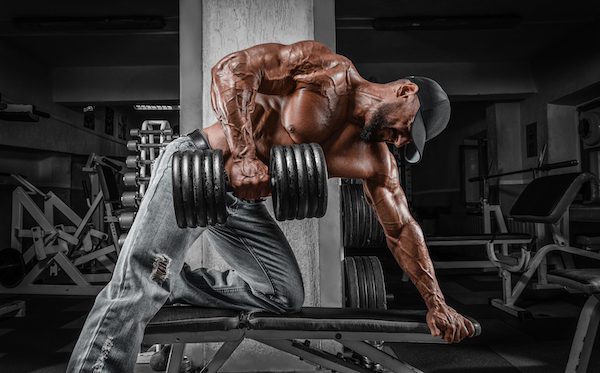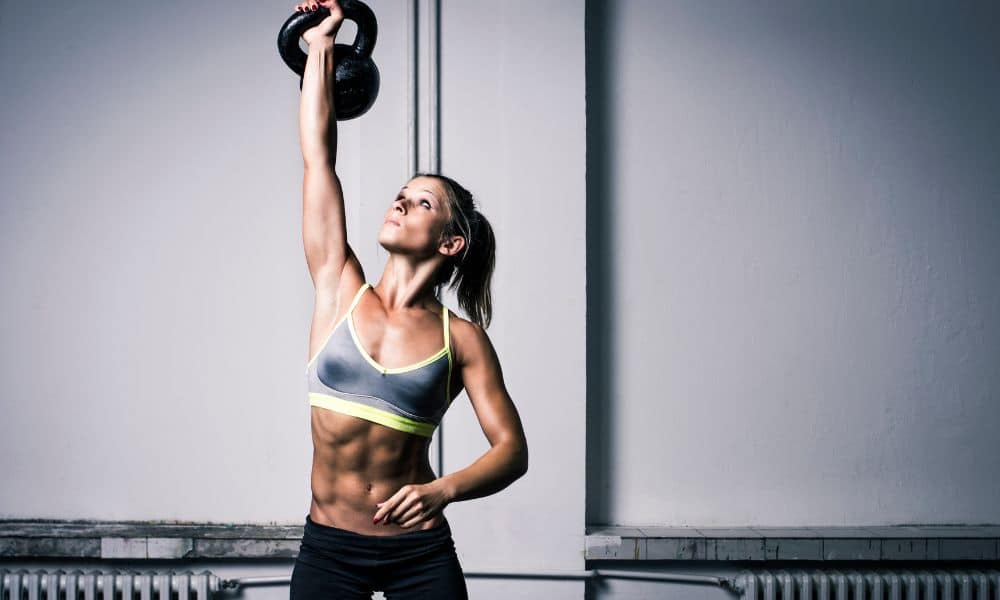Are you looking for a muscle growth training plan that consists of a push-pull chest workout for your upper body? Use this flexible nonlinear periodization plan with 2% to 5% progressive overload that works the chest and back.
Mastery includes completing each superset at the desired weight, sets, and rep range. The push-pull chest workout includes the following exercises: standard bench press, bent-over row, incline bench press, T-bar prison row, decline bench press, rack pulls, dumbbell chest fly, one-arm dumbbell back row, dips, and pull-ups or chin-ups. Performs five supersets of 8 – 12 reps of 65% – 85% of one-rep-max with a rest time of one to two minutes.
Thus, the push-pull chest workout shall consist of the following exercises, sets, reps, and rest time:
| Exercises | Sets | Reps | Weight | Rest |
| 1. Standard Bench 2. bent-over row | 4-6 | 8-12 | 70% – 80% of one-rep-max | one to two minutes |
| 1. Incline bench 2. T-bar prison row | 4-6 | 8-12 | 70% – 80% of one-rep-max | one to two minutes |
| 1. Decline Bench 2. Rack Pulls | 4-6 | 8-12 | 70% – 80% of one-rep-max | one to two minutes |
| 1. Dumbbell Chest Flyes 2. One-Arm Dumbbell Row | 4-6 | 8-12 | 70% – 80% of one-rep-max | one to two minutes |
| 1. Weighted Dips 2. Pull-ups or Chin-Ups | 4-6 | 8-12 | 70% – 80% of one-rep-max | one to two minutes |
| Warm-up 1. Rowing machine – 5 mins 2. Push-ups 3. Superman with frog stroke | 1-3 | 5-10 | Bodyweight | one minute |
| Cool Down 1. Walk – Treadmill 2. Chin bar hang, 3. Vertical bar grab, 4. lats pull-down machine. 5. Pec Dec, 6. Vertical bar push, 7. Cable-crossover machine | 1 | 5 mins 5-10 reps | Bodyweight – Hold for 20 to 30 sec | one minute |
Chest and Back Push-Pull Superset Workout
This type of training creates muscle hypertrophy. Science has long held that muscle hypertrophy occurs when using 6 to 12 reps for 10 – 20 sets each week. Thus, supersets using a push-pull chest workout optimize workout time. This type of workout program was made famous by Arnold Schwarzenegger. Push-Pull supersets improve the symmetrical development of opposing muscle groups. In this workout, we focus on the chest and back.
The chest and back anatomical structure dictates the type of exercises. While the chest may seem simple, the muscle fiber moves upward, across, and downward. This occurs because the chest is divided into the pectoralis major and minor with upper, middle, lower, inner, and outer muscle fibers. Also, the back is just as complex as it is composed of the lats, trapezoids, rhomboids, and a few minor muscle groups. Thus, the angle and range of lifts must vary to optimize muscle hypertrophy for the chest and back.
Reps and Sets, One-Rep-Max, and Progressive Overload
According to statistical data, the reps dictate the weight as most people can perform 6 to 12 reps at 70% to 85% of one-rep-max. Therefore, a person performing 10 reps can generally do it with 75% of one rep max. The goal is to work the muscle to the point of exhaustion but not failure. This can be done with progressive overload by increasing the weight by 5 pounds for each exercise until the targeted reps and sets are no longer mastered. Once targeted reps and sets are no longer mastered, you can use progressive overload to increase reps until targeted reps are mastered again.
Thus, a cycle begins where you increase the weight until the targeted reps and sets cannot be completed. After that, you continue with the weight until you can complete 12 reps again; after the reps return to the targeted zone, once reps return to the desired range, the process starts over by increasing the weight again.
Rest Time
A rest time of 1 to 2 minutes accesses the glycolytic energy pathway, which is optimum for muscle and sarcoplasmic hypertrophy. Thus, the workout will last between 40 – 90 minutes ( 5 supersets x [4 – 6 sets] x [2 – 3 mins exercise and rest time]) based on reps, sets, rest, and workout time. A range is provided to account for individual differences in reps and rest time due to progressive overload.
Flexible Nonlinear Periodization Plan
A flexible nonlinear periodization plan allows for high intensity on high-energy days and low intensity on low-energy days. Many bodybuilders like Jay Cutler, four-time Mr. Olympia, advocated for this periodization plan. Jay stated there is no magic formula for working out. He listens to his body and workout accordingly. Therefore it is more important to listen to your body than follow a schedule. Make sure you catch your breath between sets to build muscle and not endurance.
Warm-Up and Cool Down
The push-pull chest workout begins with a dynamic warm-up. Since you are performing chest and back exercises, calisthenics should be used to warm up the chest and back. Thus, pushups for the chest, shoulders, and triceps, and the superman exercise with a frog stroke using the arms while keeping the feet stationary can be used for the lower and upper back. Also, for the cooldown, walk for 10 minutes. Walking is a therapeutic compound exercise that cools the body down but also starts the recovery period.
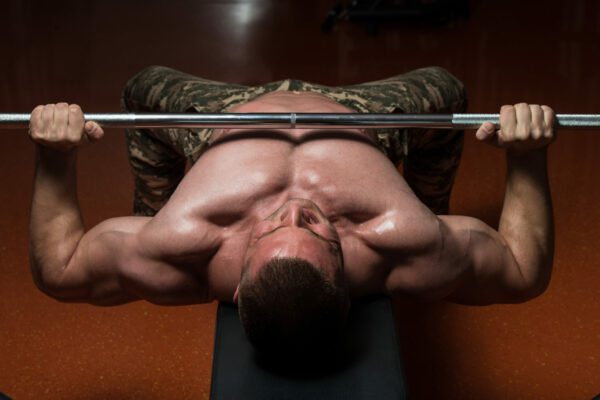
Bench Press
The first superset during this push-pull chest workout includes the standard bench press and the bent-over row. The bench press requires 5 contact points. Ensure that the butt, back, shoulders, and head remain on the bench, the feet stay flat on the floor, and the elbows remain at a 45-degree angle to the torso. Also, during the exercise, maintain a 4-1-2-1 cadence.
The cadence requires the eccentric movement to be performed in four seconds while squeezing the shoulder blades together and bringing the weight down. During eccentric movements, this allows for muscle stretch and activates muscle spindles. The cadence requires you to hold the contracted shoulder blades at the bottom of the lift for one second. During the concentric movement, flex the pecs, press the weight upward in two seconds, and pause at the top of the lift for one second to complete the cadence.
The one-second pause on the isometric movement is essential because it creates a mind-to-muscle connection forcing the chest to be the primary mover. At the same time, the triceps and shoulders are assistant movers. The research shows that the bench press works the middle of the chest and that there is a correlation between the one rep max bench press and chest size.
Bent-Over Row
During the bent-over row, focus on form. As you tire, keep good form and perform the reps correctly. This can be done by keeping the back arched and squeezing the shoulder blades during the concentric movement. Also, focus on bringing the elbows past the torso while touching the abdominals with the barbell. Then hold the contracted shoulder blades for one second at the end of the concentric movement. Next, release the weight slowly while performing the eccentric movement.
Like, the bench press, remember to use the 4-1-2-2 cadence. Thus the eccentric movement takes four seconds to release the weight downward, one-second pause at the bottom of the lift, two seconds to perform the concentric movement, and another one-second pause at the top of the lift. This will help to control weight and keep good form. Ronnie Coleman, the most decorated Mr. Olympia, said everyone uses the same exercises. The difference is in how the exercises are performed. The bent-over barbell row works the lats, lower back, and biceps. The lats are the primary mover, while the lower back and biceps are the assistant movers. By performing the excise correctly, you get better results with the muscles you intended to work.
Incline Bench Press
The second superset during this push-pull chest workout includes the incline bench press and the T-bar row. The incline bench is used at 30 to 60 degrees. The incline bench press works the upper chest, shoulders, and triceps. The upper chest is the primary mover, while the shoulders and triceps are the assistant movers. The elbows should remain at a 45-degree angle from the torso during the incline bench press. The incline bench press requires 5 points of contact. The head, back, shoulders, and glutes remain flat on the bench, while the feet remain flat on the ground.
During the incline bench press, adhere to the 4-1-2-1 cadence. After unracking the weight, slowly lower the weight by squeezing the shoulder blades and gently touching the chest. The eccentric movement will be performed in four seconds. Once you complete the eccentric movement, pause while maintaining the squeezed shoulder blades for one second. Next, complete the concentric movement while contracting the chest muscles and pressing the weight in two seconds. Hold the contracted pecs at the top of the lift for one second. Control the weight using good form as you move the barbell on a vertical path, and contract the shoulder blades and pecs during the concentric and eccentric movements. Keep your shoulders tucked in at a 45-degree angle. This works more of the chest and less of the triceps. Also, it allows the shoulders to make a natural rotational move during the press.
T-Bar Prison Row
During the T-bar prison row, assume a bent-over position with an arched back. Place feet shoulder-width apart. Next, grab and raise the barbell by bending and raising the elbows as high as possible until the barbell touches the abs. During the concentric movement, squeeze the shoulder blades. Maintain control of the weight and use the back primarily to perform the concentric movement. Use a 4-1-2-1 cadence to perform the T-bar prison row and keep the torso parallel to the floor during the exercise. The T-Bar prison row will work the lats (primary mover), lower back (assistant mover), and biceps (assistant mover). Focus on the elbows and shoulder blades to control the weight, complete the range, and use proper form. Also, inhale during the eccentric movement and exhale during the concentric movement.
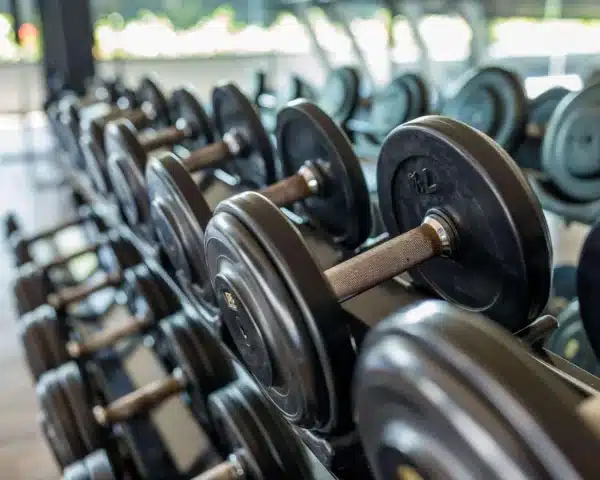
Decline Bench Press
During this push-pull chest workout, the third superset includes the decline bench press and partial racks. The decline bench press works the lower chest. An angle of 20 – 30 degrees is the most effective for the declined bench press. You can use a heavier weight on the decline bench press because of the anatomical structure of the chest. The pec muscles perform flexion and adduction of the upper arm, which the decline bench press uses. Therefore, the decline bench press is a natural movement for the chest.
Place both feet under the leg brace to perform the decline bench press to keep the body stationary. Use a hand grip slightly wider than shoulder width. Then perform the eccentric movement by lowering the weight to the chest. Use a 4-1-2-1 cadence to perform the lift correctly and under control. Squeeze the shoulder blades together as you bring the weight down. This will allow you to stretch the chest muscles activating more muscle fiber. Keep the barbell on a vertical path while using the sternum as a focal point. Hold the shoulder blade squeeze for one second at the bottom of the lift. On the concentric movement, squeeze the chest muscles while pressing the weight. The concentric movement will take two seconds. Once the concentric movement is completed, hold the chest squeeze at the top of the lift for one second before starting the next rep.
Partial Rack
The partial rack works the lower back, glutes, hamstrings, quadriceps, trapezius, and lats. The partial rack is used for an overload because of the weight load that can be performed with this exercise. This exercise works extremely well for developing a thick back. The back is the primary mover for the partial rack, and the hamstrings, quadriceps, and glutes are the assistant movers in this exercise. The partial rack is a favorite for people who can’t perform deadlifts due to lower back problems. Also, the partial rack is more manageable in a superset than a deadlift. It is best to perform major lifts like the bench press, squat, back rows, and deadlifts first because they are compound lifts taxing the muscles and nervous system. Dorian Yates replaced the squat in his workouts with a leg press because of a hip injury early in his career. Thus, exercises should be selected for compatibility, not because they are superior.
To perform the partial rack, place a barbell on a squat rack. Then use the roman deadlift stance. The bar can be 2 inches above or 2 inches below the knees. Slightly bend the knees, as with other back exercises, and keep a neutral spine position by arching the back. As with proper deadlift form, stand with feet hip-width apart. The hand grip should be shoulder-width apart. You can use an under/overhand or overhand grip. If you have smaller hands or weaker grips, use an under/over hand to perform the lift. Rack pulls, deadlifts, and variations of the deadlift build hand grip strength and inform hand grip strength. Move the weight on a vertical path while not bending the elbows. During the exercise, move the weight by pressing the feet into the ground and thrusting the hips forward.
The partial rack is a compound joint moving exercise that works the upper and lower body. As you perform the concentric movement, lock the knees and hips at the top of the lift. Also, bend the knees and hips during the eccentric movements of the partial rack. You will work the lower body through the concentric and eccentric movements of the lift while working the upper body through the isometric movements. This will prevent injuries and not exhaust pre-existing lower back problems.
Dumbbell Flys
During this push-pull chest workout, the fourth superset includes the dumbbell flys and one-armed dumbbell row. The dumbbell flys are an isolation chest exercise. Bodybuilders have used chest flys for decades. The chest fly works the chest (primary mover) and the shoulders (assistant mover). If you have a history of shoulder injuries, avoid this exercise because it puts stress on the shoulders.
To perform the chest flyes, lay on a bench with your feet flat on the floor. With the dumbbells in both hands and touching each other, the arms will extend over the chest. Perform the dumbbell flys with a 4-1-2-1 cadence. As you perform the eccentric movement, contract the shoulder blades and open the chest slowly and controlled while keeping the elbows fixed. This will stretch the chest muscles as you ultimately lower the dumbbells. At the bottom of the lift, squeeze the shoulder blade for one second. The elbows will stay bent at 10 – 15 degrees during the concentric movement. Do not rotate the shoulders, elbows, or wrists. Exhale and perform a hug-like movement when performing the concentric movement. This will force the chest to be the primary mover instead of the shoulders or the arms.
Finally, keep mechanical tension and stretch the chest muscles. The focus of the dumbbell chest fly is an eccentric movement because this is where the chest is open and under the most tension. Stretch position movements elicit hormone responses and activate muscle fibers that were not hit by compound movements. Also, inhale during the eccentric movement, which will expand the lungs and help the chest to open.
One-Arm Dumbbell Row
The one-arm dumbbell row works the lats (primary mover) and the biceps (assistant mover), and the obliques (assistant mover). The one-arm dumbbell row is an isolation move.
To perform the one-arm dumbbell row, the bodybuilder will lean on the bench with knee and arm, keeping the torso parallel to the ground. Also, keep the back arched. This will keep the back neutral and not compromised. Row the weight to the hip by lifting the elbow as high as possible. Remember to row the weight as close to the hip as possible. This will allow you to perform the exercise with the correct form and access the optimum bath way for back muscle activation. Finally, breathe correctly during the exercise, and use a 4-1-2-1 cadence. This will allow you to perform the exercise with the best form while optimizing your energy levels.
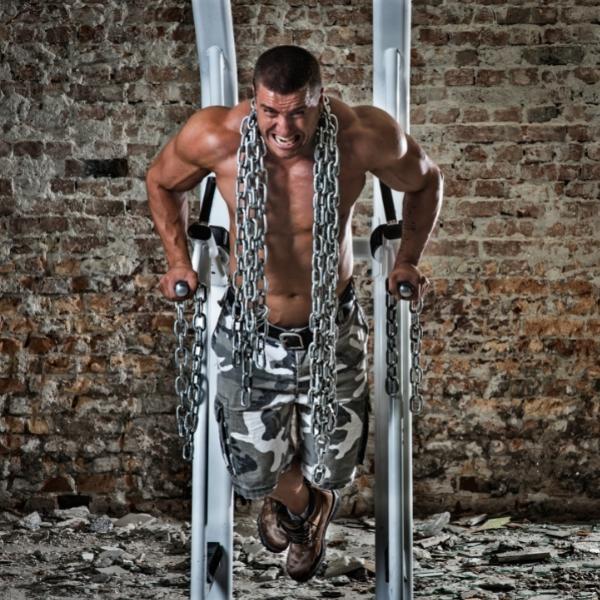
Weighted Dips
The fifth superset during this push-pull chest workout includes weighted dips and chin-ups. The weighted dips are a chest exercise that works the chest (primary mover) and the shoulders (assistant mover), and the triceps (assistant mover).
Begin the weighted dips with elbows extended. Squeeze the shoulder blades and raise the chest as you perform the eccentric movement. Also, lean forward slowly while performing the eccentric movement under control. During the eccentric movement, bend the elbows until the elbows reach a 90-degree angle. At the bottom of the exercise, pause for one second. Remember to pause for a second during the isometric movement. As you press upward, keep the elbows out, tuck the chin to the chest and lean forward. This is important because the more upright posture with elbows tucked in works the triceps more. As you perform the concentric movement, press up under control which should take two seconds or less. During the weighted dip, make sure to use a 4-1-2-1 cadence to help perform the exercise correctly.
Pull-Ups/Chin-UPs
The pull-up and chin-up work the lats and the biceps. To perform pull-ups and chin-ups, grip the bar with an underhand grip and an overhand grip for pull-ups at shoulder width, with the elbows fully extended at a dead hang. Keep the legs straight and knees locked as you perform the concentric movement from a dead-still position. Also, extend the chin above the bar and hold it for one second. Perform the eccentric movement in four seconds and pause at the bottom of the exercise for a second. Keep the legs straight, knees locked, and body controlled by not rocking. Also, use a 4-1-2-1 cadence during the exercise to perform the exercise correctly. Finally, inhale during the concentric movements and exhale during the eccentric movements. Pull, and chin-ups require you to follow a vertical pathway when performing the exercises.
The Last Word on Chest Push-Pull Workout for a Muscle Growth Training Phase
After the push-pull chest workout, perform 10 minutes of walking to cool the body down and start the recovery period. Consider your strengths and weaknesses after performing the workout. What did you do well? This will help you to make adjustments and plan future workouts. Building the body is about working on your weak areas to bring them up to the level of your strengths. This will allow you to make new goals that provide you with results. Also, use diet and sleep to increase the effects of your workout. Finally, remember to use good form, cadence, progressive overload, and a periodization plan to maximize your push-pull chest workout.

